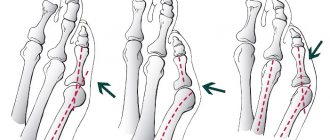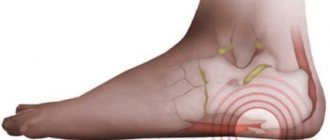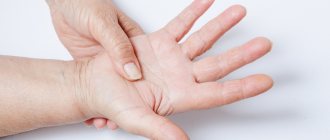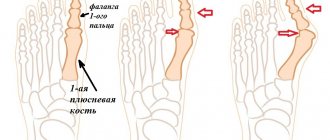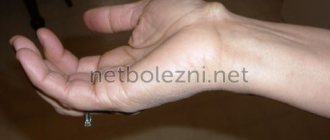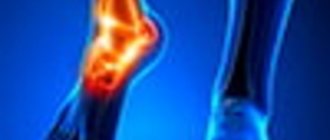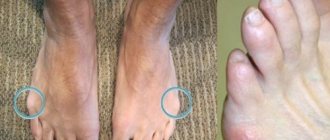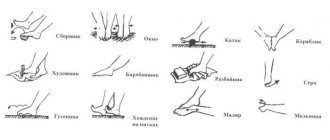Throughout our lives, our feet are exposed to enormous stress. In order not to aggravate the already deplorable condition and to preserve their health as much as possible, it is worth taking care of your legs in a timely manner. However, sometimes problems can arise with them: varicose veins, atherosclerosis, arthrosis... Diseases can hide inside our legs and often go unnoticed. But they often appear on the surface, for example, in the form of strange bumps. We will talk about such a common phenomenon as bumps on the legs (on the instep of the foot).
Why do bumps appear on my feet?
When something foreign appears on the body, it is always alarming. And all because sometimes even a completely harmless mole or bump can be dangerous and lead to serious and irreversible consequences.
A suddenly growing lump on the instep of the leg should not be ignored. Because this often indicates that something is wrong with your body.
Our foot is quite complex. It consists of 25 different bones, which are connected by tendons. If the load on the feet is too great, the tendons weaken and cease to cope with their functions. The bones separate a little, and lumps appear in these places.
Most often, bumps grow on the legs on the instep of the foot. This is explained by the fact that there are no tendons between the first and second phalanges of the toes - this is the most vulnerable place of our foot.
Possible reasons for the appearance of a bump on the leg (where the instep is):
- Uncomfortable shoes. This primarily applies to women who love unstable heels and platforms. The foot in such shoes experiences a lot of pressure, and the result of this load is bumps and growths on the instep.
- Consequence of injury. A sprained foot tendon is the most common injury among athletes, for example. But it’s not just people involved in sports that can get this type of injury. You can sprain or sprain your leg as a result of an accident or simply due to negligence.
- Flat feet. With this diagnosis, the appearance of bumps on the foot is one of the primary symptoms. This is due to the fact that with flat feet, the strength of the tendons weakens, vulnerable spots appear between them, on which growths form.
- Occupational Illness. There are some types of professions in which the legs are primarily involved. These are ballerinas, gymnasts, figure skaters and other athletes. The stress on their feet and toes is so great that bunions on the instep are very common.
- Excess weight. An increase in body weight and, accordingly, load on the legs can provoke the appearance of bumps on the feet.
All these reasons are connected by one very important fact: bumps appear at the sites of tendon injury, and there is a special medical term for them - foot hygroma.
What else causes a violation of the structure of the vaults?
Other factors that contribute to the violation of the arches of the foot and deviation of the metatarsal bones and toes include large static loads.
Lower arches also result from increased stress on the ligaments, tendons and muscles of the foot, such as:
- hard physical work,
- wearing ill-fitting shoes,
- incorrect choice of work and rest modes,
- overweight .
Regardless of congenital or other factors leading to the development of deformity, deviation of the metatarsal bones and fingers, or drooping arches, treatment of the deformity is possible. Elimination of these harmful factors is an important component in the treatment complex.
What is hygroma?
If the tendon joints or joints of the foot are injured, under no circumstances should it be left unattended. In places where there is a tear, serious pathological changes often begin, connective tissue cells degenerate, and a tendon cyst is formed, which is called a “hygroma.”
Although the hygroma seems quite rigid to the touch, it is actually hollow inside. The shell is a cartilaginous capsule containing a thick yellowish mass. Hygroma cells divide, which explains its gradual increase in size.
Hygroma of the foot in a child
A bump on the instep of a child’s leg is a rare occurrence. Most often it occurs due to improperly selected shoes. To avoid such trouble in the future, try to prevent your child’s shoes from being too small, stinging his toes, or rubbing against calluses. Watch the size carefully, do not let children wear what they have outgrown. The foot in such shoes bends and deforms unnaturally. The situation is further aggravated by the fact that the child’s bones and veins are fragile, and it won’t be difficult to damage them, but it may not be possible to restore them.
Also, hygroma on the instep of the foot can appear in child athletes who put a lot of stress on their legs. The health of such children must be monitored especially carefully.
Other consequences of vault violations?
The resulting tendon-muscular imbalance as a result of drooping arches of the foot leads to outward deviation of the first toe (valgus deformity of the first toe develops, hallux valgus), deformation of the 2-4 toes (hammer, claw, hammertoe), and varus deviation of the 5th toe (Taylor's deformity).
| Valgus deformity of the first finger, hammertoe deformity of the second finger | Valgus deformity of the first finger, hammertoe deformity of the II-IV fingers |
Changing the shape of the arches, their inconsistency will lead to an increase in the load on the ligaments and tendons, on certain joints. As a result, degenerative changes develop in these joints - arthrosis.
Due to the flattening of the transverse arch, the heads of the 2-4 metatarsal bones move down. Constant pressure of the heads of the metatarsal bones on the soft tissues leads to roughening of the skin of the sole under the heads, corns appear, and pain in the area of the heads is metatarsalgia.
As a result of the pressure of the metatarsal heads on the plantar digital nerve, Morton's neuroma can form.
| X-ray and appearance of the foot with arthrosis of the first metatarsophalangeal joint | Corns on the sole of the foot |
Hygroma of the foot in an adult
Most often, a bump on the foot on the instep of the foot (photo above) grows in women. The causes are uncomfortable shoes (heels), constant stress on the feet and a lack of calcium and collagen, which is washed out of the body in large quantities during pregnancy and menstruation. Because of this, joints and bones become fragile and easily deformed.
Also at risk are people aged 40-50 years. This is because over the years, joints wear out and tendons weaken. At this age, you should be more careful about the health of your feet.
Normal foot anatomy
The bony skeleton of the foot consists of 28 bones, both large (calcaneus) and small (sesamoid). Being part of a larger system, each of them performs a specific but important role. These bones form joints among themselves and are strengthened by ligaments, tendons and muscles. Among these tendons and ligaments, there are very short and long ones, individually they may not be very important, but collectively, they play an important role in maintaining the shape and function of the foot.
Symptoms of manifestation
In order not to miss a serious disease and start treatment on time, you need to carefully monitor all changes in your body. Bumps on the instep of the foot are not so difficult to notice, especially since in most cases they cause obvious inconvenience.
How to notice the problem in time? First of all, pay attention to the symptoms:
- Redness or swelling at the top of the foot. Most often, this symptom indicates the onset of an inflammatory process.
- The appearance of a pronounced tubercle. Usually the tumor appears in a single specimen, but upon closer examination, several more tendon cysts may well be discovered.
- Pain when pressing on the lump or discomfort when walking. As a rule, if the leg is at rest, no pain is felt, and the lump itself may even decrease slightly in size. But if you put stress on your leg, the discomfort may return.
- When examining the lump with your fingers, you will notice that it feels soft rather than hard to the touch.
- If there is a blood vessel running next to the lump, the tumor is quite capable of compressing it. Then, to the above symptoms, increased pulsation in the foot and its coldness are added.
The appearance of a bump on the leg while instep (photo in the article) should never be ignored. You should immediately contact a specialist. All these symptoms are typical for most patients, so the specialist determines the nature of the neoplasm immediately upon examination. In complex and ambiguous cases, additional diagnostics are prescribed.
Hallux valgus - symptoms and treatment
Over the past hundred years, foot surgery has not only not lost its relevance, but is also making constant steps forward, with the advent of more advanced instruments and fixators. At the moment, more than 400 types of operations and their modifications have been developed to correct deformities of various parts of the foot.[5][16]
With initial changes, you can get by with a low-traumatic operation - McBride, Silver's method, R.R.'s method. Vredena.[13] In this case, the bone is not sawed, but the attachment site of the tendon of the adductor pollicis muscle is changed. The recovery period is minimal and lasts 2-3 weeks.
If grades II and III are diagnosed, then a more traumatic operation is performed - osteotomy (cutting of the bone) with setting the correct angle and fixation with screws or knitting needles.[12][15] There are many methods for correcting the first finger:
• Distal (used if the angle between the 1st and 2nd metatarsal bones is no more than 14°): Schede operation - removal of exostosis (“bump”), subcapitate wedge-shaped osteotomy according to J. Reverdin, TR Allen operation, DW Austin operation (chevron osteotomy);
• Diaphyseal (used if the angle between the 1st and 2nd metatarsal bones is from 15° to 22°): Z-shaped osteotomy M. Meyer (scarf), operation K. Ludloff, osteotomy CL Mitchell;
• Proximal (the angle between the I and II metatarsal bones is more than 22°): double osteotomy according to Logroscino, wedge-shaped osteotomy by M. Loison, E. Juvara, osteotomy according to GW Patton and JE Zelichowski;
Sometimes, if there is a deformity of the main phalanx of the first finger, an additional OF Akin (Moberg) osteotomy is required.[13]
The choice is made by an orthopedic traumatologist, taking into account the localization of the main changes, the congruence of the first metatarsophalangeal joint (preservation of articular surfaces) and the severity of the pathology.
If the first metatarsophalangeal or metatarsocuneiform joint is destroyed by deforming arthrosis or other pathology, then arthrodesis (jamming, immobilization of the joint) or, in rare cases, endoprosthetics is performed.[16]
After the operation, the patient walks for 4 weeks in special shoes (Baruka), which are needed to unload the forefoot. After control X-rays, the doctor allows you to walk, loading the entire foot, but limiting heavy and sports activities. As a rule, after 2 months the patient returns to his normal lifestyle. The fixing screws are not removed and do not cause any discomfort.
To correct the “small” rays of the foot (II-IV metatarsals), Weil techniques, subcapital hinge osteotomies, and DMMO are used.[9][15] To correct Taylor deformity (V metatarsal) - Willson, Bosh and DMMO techniques.
The following techniques are used to correct planovalgus deformities:
- tendon transposition;
- medializing osteotomy of the calcaneus; Cotton's operation;
- lengthening of the lateral column;
- arthrodesis of the Lisfranc joint;
- arthroeresis;
- three-joint arthrodesis.[1][6]
The main goal of modern treatment methods is to bring all anatomical and functional parameters as close as possible to normal. Ignoring the individual characteristics of the foot and choosing the wrong treatment method lead not only to recurrence of the deformity, but also to its aggravation.[18] Abandonment of well-known and proven operations and mass infatuation with new ones, as well as blind use of the same operations for decades, without taking into account the individual characteristics of each foot, are categorically unacceptable.[13]
Treatment of hallux valgus almost always begins with the selection of comfortable shoes that do not cause friction or stress. Nonsteroidal anti-inflammatory drugs and physical therapy may be prescribed to reduce inflammation and pain.[6] In addition, corticosteroid injections are possible.[11]
Various orthopedic products are used (instep supports, toe correctors, interdigital rollers). The use of orthopedic devices helps little in the early stages to stop further deformation.[10] With severe deformation, the use of orthopedic products can only slightly reduce pain.
Orthotics are an integral part of the treatment of foot deformities.[17] In most cases, standard insoles are not effective, so it is better to use custom insoles made specifically for your foot.[12] A prerequisite: if you wore orthopedic insoles before surgery, you need to replace them with new ones afterward, since the corrected foot changes its characteristics.
We diagnose correctly
In order for the diagnosis to be made correctly and treatment to be prescribed in a timely manner, it is necessary to accurately determine the nature of the origin of the lump on the instep of the leg. For this, the following medical diagnostic methods are used:
- Ultrasound. Using this method, you can determine where the tumor is located and what size it is.
- X-ray. Allows you to accurately determine the location of the lump and prescribe further treatment. Intraosseous damage or joint injuries are clearly visible on x-rays.
- Magnetic resonance or computed tomography. Used in particularly serious cases where internal damage cannot be seen using the two previous methods.
- Diagnostic puncture. The most accurate way to determine the nature of a neoplasm. To do this, the internal contents of the cone are taken for examination with a special needle. Using a puncture, the benign quality of the lump is determined.
Only a doctor can prescribe one or another diagnostic method for you, based on the results of an external examination.
Types of conservative treatment for cones
Please note that all treatment methods for bunions on the foot (on the instep of the foot) listed below are relevant only for the initial stage of the disease. If the problem has been bothering you for quite a long time, only surgery can help.
If the appearance of a tumor on the leg is noticed in time, you can try to treat it yourself. But even in this case, consultation with a specialist is necessary, otherwise you can only harm your health.
Conservative treatment methods include, for example, puncture of the internal contents of the hygroma, crushing (in which the contents are squeezed out of the capsule and penetrates the tissue), sclerosis and physiotherapy (electrophoresis, laser and magnetic treatment). All these methods can bring only temporary relief, but they do not solve the problem. The hygroma capsule remains in the same place and after some time will begin to fill with liquid again, which means it will increase in size.
Treatment
Lump from an inflammatory process If the foot is swollen on top, then most likely there is an inflammatory process of the soft tissues. This may occur due to injury. It is necessary to contact a surgeon to open the abscess and clean out the pus. Further treatment consists of changing the therapeutic bandages. Antibacterial therapy may be required. In the initial stage of the appearance of a bone growth on the instep of the foot, you can cope with the problem using conservative methods. Depending on the cause of the disease, the prescription of pharmaceutical drugs is required. For an examination, you need to contact an orthopedist, who will determine the degree of joint and bone tissue disorders. Do not delude yourself and believe the words of various healers who claim that you can get rid of a bump on the foot with the help of ointments and lotions. No pharmaceutical or folk remedies will help dissolve or soften a bone growth on the foot. They only relieve pain for a while, without reducing the size of the lump. And even after surgery, the lump may reappear if no preventative measures are taken.
Traditional methods of treatment
Information on how to treat a bump on the instep of the leg can be found in reference books on traditional medicine. Let's look at the most common recipes.
Cabbage leaf and honey. Steam your legs properly. Lubricate the pine cone with honey and place a slightly mashed cabbage leaf on the area. Bandage and leave this compress overnight. Cabbage juice can also be taken orally for one month. You need to drink it daily, 1 glass.
Blue clay. This method is very popular among people due to the healing properties of clay. Mix it with water until it reaches the consistency of plasticine and apply it to the hygroma. Wrap in film and bandage. You need to keep the clay for 3-4 hours.
Salt baths. They will help relieve pain and relieve tension in muscles and joints. It is better to use sea salt.
Celandine juice. This method should be used regularly, every 3-4 days. Soak the bandages in celandine juice and wrap them around the lump. Leave it on all night.
Surgical removal of hygroma
This is the only treatment option that gives almost absolute confidence in getting rid of an unpleasant disease. We say almost because the possibility of relapse cannot be ruled out. A lump on the instep of the leg can grow back if the tumor cells are not completely removed. Then a new hygroma can form from the remaining pathological tissues.
The operation to remove a bunion on the leg is planned and completely ordinary. It is performed under local anesthesia; general anesthesia is recommended only for children under 10-12 years of age.
Postoperative measures
- You should not put any weight on your leg for some time after surgery. Keep it quiet often to ensure successful healing.
- If necessary, take care of the postoperative suture at the site of excision of the hygroma. The doctor will tell you all the necessary information.
- Follow all medical recommendations. You may be prescribed a complex of vitamins and minerals to strengthen bones and tissues.
- Try to eliminate the unfavorable factor that led to the lump. Change your shoes to more comfortable ones, do your work more carefully, otherwise the hygroma will appear again.
Biomechanics of the foot. How does it work?
The foot performs its support-spring function due to the arches. The foot is a living system, fixed like puffs, i.e. tissue formations.
Arch strength is provided by passive and active supports. The ligaments (passive holders) are quite strong and cannot withstand prolonged tension. Muscles (active holders) have greater contractile strength and endurance to load and play a major role in the strength of the arch of the foot.
The arches of the foot are imaginary lines. The transverse arch passes through the heads of the metatarsal bones, the longitudinal arch through the bones of the hind, middle and forefoot.
| Arches of the feet |
The foot is a dynamic system where, under the influence of loads, the arches change their shape. Thanks to its elastic and elastic properties, in a normal foot the shape of the arch is restored. The normal functioning of the arches depends on the correct location of the bones, the condition of the ligaments, tendons and muscles.
Reviews about the treatment
Statistics show that more than 60% of patients using conservative or traditional methods of treatment note the recurrence of hygroma on the instep of the foot. Moreover, 95% of those who decided to undergo surgical removal eventually got rid of the disease forever.
Many patients who have a lump on the instep of their leg (photos attached) respond positively to the laser method of removing hygroma. The advantages of this operation are that after it there are no marks left on the skin, and the rehabilitation period is halved.
Preventing the appearance of bunions on the instep of the foot
If you have a bunion on your instep, or you want to prevent it from appearing in the future, listen to the following recommendations:
- Review your diet. Include more vegetables and fruits in it, eat more fish, which contain substances that are beneficial for joints.
- Change your shoes to more comfortable ones. Ditch high heels in favor of more stable soles.
- Avoid excessive stress on your legs and hypothermia.
- At the slightest suspicion of hygroma, consult a specialist to rule out its malignancy.
Prevention
The patient must do the following:
- Change your shoes to soft, low-heeled ones. In this case, it is advisable to place a soft liner where the lump comes into contact with the leather of the shoe.
- If there is a heavy load on the legs due to work, it is necessary to adhere to the “work-rest” regime.
- With a sedentary lifestyle, it is necessary to perform exercises that strengthen muscles and ligaments to avoid injuries.
- Using orthopedic shoes helps reduce stress. When walking in such shoes, the foot is securely secured with the help of rigid fixing inserts.
- It is recommended to take relaxing foot baths with herbs, such as chamomile, and salt before bed, which will help relieve muscle tension.
- Walk barefoot more. You can use special massage mats in winter. In summer it is useful to wander on sand or round small pebbles. This stimulates blood circulation in the legs well.
- It is mandatory to take a vitamin complex with a high percentage of calcium, vitamin D and B vitamins.
- The diet should be healthy and consist mostly of vegetables and fruits. Fish is healthy because it contains unique substances that are beneficial for joint function.
- Do not neglect medical recommendations. It is necessary to examine the body for possible negative deviations in the functioning of organs and systems.
Some doctors are inclined to believe that the cause of many diseases is the presence of parasites in the body.
Feeding on the substances necessary for cell renewal, they secrete toxic products of their vital activity. This contributes to the development of deficiency of many vitamins and minerals and disruption of organ function. Share:
Expert advice
- Attempts to open or pierce a hygroma on your own, in the hope that the contents will come out and it will resolve, are strictly prohibited. This will not happen, you will only harm your health and make the situation worse.
- On the injured area of the foot, use special soft inserts when wearing shoes. If the hygroma causes severe inconvenience, you can try special orthopedic shoes.
- Folk remedies should be used only in addition to the main one. And do not forget about the need to consult a specialist. Don't self-medicate!
